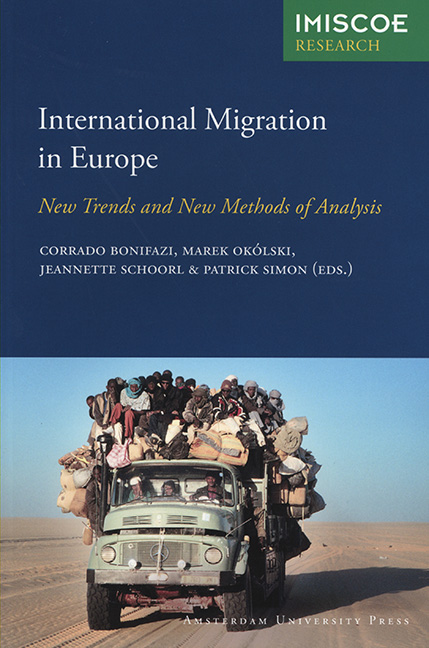Book contents
- Frontmatter
- Contents
- Preface
- 1 Introduction
- PART I NEW FORMS OF MIGRATION IN EUROPE
- PART II EVOLUTION OF REGIONAL PATTERNS OF INTERNATIONAL MIGRATION IN EUROPE
- PART III MEASURING INTEGRATION: IMMIGRANTS AND THE SECOND GENERATION
- PART IV SPECIAL SURVEYS IN INTERNATIONAL MIGRATION STUDIES
- List of Contributors
- Index
- Other IMISCOE Titles
8 - Foreign Immigration in Southern European Receiving Countries: New Evidence From National Data Sources
Published online by Cambridge University Press: 22 June 2021
- Frontmatter
- Contents
- Preface
- 1 Introduction
- PART I NEW FORMS OF MIGRATION IN EUROPE
- PART II EVOLUTION OF REGIONAL PATTERNS OF INTERNATIONAL MIGRATION IN EUROPE
- PART III MEASURING INTEGRATION: IMMIGRANTS AND THE SECOND GENERATION
- PART IV SPECIAL SURVEYS IN INTERNATIONAL MIGRATION STUDIES
- List of Contributors
- Index
- Other IMISCOE Titles
Summary
Introduction
The measurement of both the dimensions and main features of the foreign population in Southern European host countries (Italy, Spain, Greece and Portugal) is not an easy task. In addition to the typical problems of statistics on migration flows and migrant population stocks, the presence of a sizeable and dynamic irregular component is a major hindrance. Even for the estimation of the legal presence, administrative sources are often not exhaustive, either because they capture different subsets of the whole universe of regular foreigners (as in the case of Italy) or because of very restrictive immigration policies preventing migrants from keeping legal status for long (Greece).
Moving within this context, this work sets out to highlight some new evidence on the recent evolution of foreign populations in Southern Europe. The approach is based on the comparison and integration of several data sources, jointly used to draw the quantitative evolution of the stock of foreigners living in the four countries in the last ten to fifteen years. Although the bulk of the analysis is focused on regular foreign presence, data from the periodic regularisation programmes are also used to stress the role of illegal migration and to emphasise the impact of such policies on the size and characteristics of the foreign population.
A strong focus of this paper is on the changes in the geographical origins of recent immigrants. Some patterns shared by all Southern European countries as well as some features specific to national contexts are pointed out. By analysing the changing structures by nationality, we try to understand how the role of the Southern European host countries has changed in the European migration scenario, making them increasingly attractive destinations especially for migrants leaving Latin America, Eastern Europe and the Balkans.
From national data sources to the measurement of the stock of foreigners
In this section, Aslan evolution of the foreign population in Southern European host countries from the beginning of the 1990s is reconstructed. The most recent trends are considered with particular attention. Since the different national data sources capture diverse subsets of the foreign population and are characterised by a variable quality of registrations, our approach strives to draw a picture as comprehensive as possible by comparing and integrating the available information.
- Type
- Chapter
- Information
- International Migration in EuropeNew Trends and New Methods of Analysis, pp. 153 - 178Publisher: Amsterdam University PressPrint publication year: 2008
- 1
- Cited by

